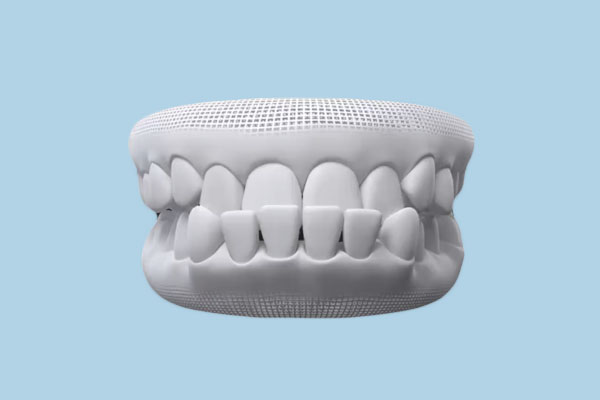Contents

Prognathism: Causes, Consequences, and Solutions
Prognathism, also known as an "underbite" or "Habsburg jaw," is a dental malocclusion characterized by a misalignment of the jaws. This condition can affect the quality of life of those affected, both aesthetically and functionally. In this article, we will explore in detail the causes, consequences, and possible solutions to correct this anomaly.
What is Prognathism?
Prognathism is a dental malocclusion resulting from a misalignment of the jaws. There are three types of prognathism:
- Maxillary prognathism: the maxilla (upper jaw) is more prominent than the mandible (lower jaw). This is often called an overjet or "buck teeth."
- Mandibular prognathism: the mandible is more prominent than the maxilla, giving the appearance of a protruding chin (underbite).
- Bimaxillary prognathism: both jaws are prominent relative to the rest of the face.
In a normal situation, the upper teeth slightly overlap the lower teeth, ensuring a good functional and aesthetic balance. However, when this inter-arch relationship is not optimal, it is called a malocclusion, a problem affecting a large portion of the population.
What are the causes of Prognathism?
Prognathism can have two main origins:
- Genetic origin: in this case, the same problem is often found in other family members.
- Functional origin: usually related to a deformation of the alveolar arch (which holds the teeth) due to factors such as:
- Thumb sucking in children
- Tongue thrusting
- Abnormal swallowing patterns
What are the consequences of Prognathism?
Prognathism can lead to numerous adverse consequences for the health and well-being of those affected:
- Aesthetic impact that can affect facial harmony and self-esteem.
- Accelerated facial aging in the case of a retrognathic maxilla (the opposite of prognathism).
- Increased risk of cavities and gum disease due to difficulty with oral hygiene.
- Functional problems such as difficulty chewing properly or respiratory issues.
- Pain in the temporomandibular joint (TMJ) and frequent headaches.
- Psychological distress related to physical discomfort and lack of self-confidence.
What are the solutions for correcting Prognathism?
The solutions to correct a protruding chin depend on the cause and severity of the jaw discrepancy. It is crucial to intervene quickly, because once the problem is established, the teeth tend to tilt to compensate for the discrepancy, making the treatment more complex.
Orthodontics: The First Line of Defense Against Prognathism
Orthodontics is particularly effective in children and adolescents to guide the growth of the jaws. It also helps to straighten misaligned teeth and harmonize the entire mouth.
For optimal orthodontic treatment, it is recommended to consult:
- At the first signs of a protruding jaw.
- Even before symptoms appear, in case of a family history.
The orthodontist will assess whether orthodontic treatment alone is sufficient or if orthognathic surgery is necessary.
Jaw Surgery: A Solution for Severe Cases of Prognathism
When orthodontics is not enough, mandibular surgery can change the position of the jawbone. This major procedure offers satisfactory results for patients suffering from a malocclusion related to a poor jaw position. It can be performed at any age, once growth is complete.
Orthognathic surgery generally involves several stages: pre-surgical orthodontics, surgery under general anesthesia, and a post-surgical orthodontic finishing phase.
Pros and Cons of Maxillofacial Surgery
| Pros | Cons |
|---|---|
| Durable and satisfactory aesthetic and functional results | Very long total treatment time (up to 3 years) |
| Correction of the most severe cases that orthodontics alone cannot treat | Risks of complications (loss of sensation, hemorrhage, relapse, etc.) |
| Potentially negative psychological impact in case of significant change |
Conclusion
Prognathism is a dental malocclusion that can have significant repercussions on the quality of life of those affected. Thanks to advances in orthodontics and maxillofacial surgery, it is now possible to effectively correct this anomaly, both in children and adults. Early diagnosis and appropriate management are essential to obtain the best results and avoid long-term complications.
FAQ about Prognathism
At what age can Prognathism be detected?
Prognathism can be detected by a pediatrician from birth. It is recommended to consult an orthodontist from the age of 6-7 for early screening and the implementation of preventive measures if necessary.
Are there alternatives to surgery for correcting severe prognathism in adults?
In the most severe cases, orthognathic surgery remains the most effective solution to correct prognathism in adults. However, orthodontic treatment can be considered as a complement to optimize the results and long-term stability.
What precautions should be taken after jaw surgery?
After orthognathic surgery, it is important to follow post-operative recommendations, including applying ice, mouthwashes, gentle brushing, a liquid diet, taking medications, and using elastics. Regular follow-up with the orthodontist and surgeon is also essential to monitor healing and treatment progress.
Is Prognathism hereditary?
Yes, prognathism can have a genetic origin. In this case, the same problem is often found in other family members. It is therefore important to monitor the jaw development in children with a family history of prognathism.
What are the psychological consequences of Prognathism?
Prognathism can have a significant psychological impact, particularly on self-esteem and self-confidence. Affected individuals may feel self-conscious about their appearance and avoid smiling or speaking in public. Early management and psychological support can help overcome these difficulties.
